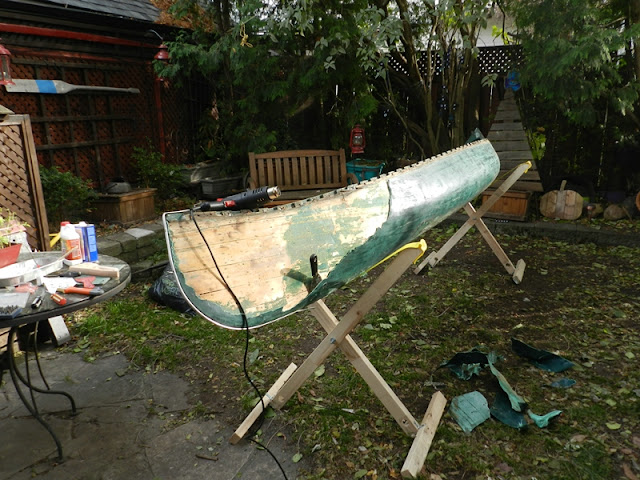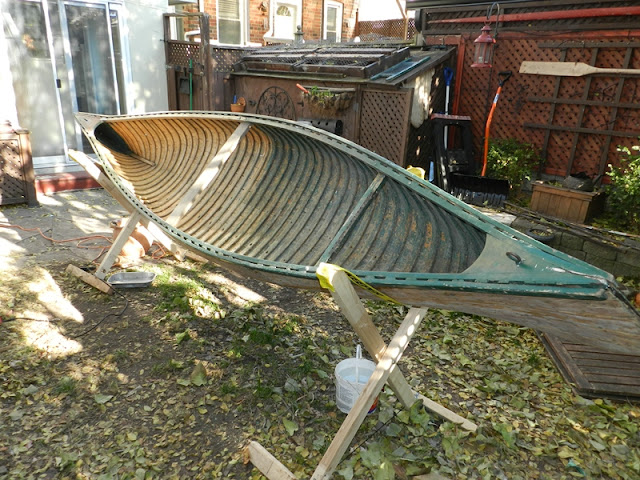
Friday, December 25, 2020
Season's Greetings

Wednesday, December 16, 2020
Trapper's Canoe Restoration: Analysis of the hull exterior
After removing the fiberglass cloth off the exterior of the hull and methodically scraping away bits of resin, the cedar planking was now fully exposed. Basically the condition of the planking could now be assessed.
A centre plank has a hole and will need to be replaced. This should be an easy repair since the planking lies flat in this area.
Basically this canoe has a little bit of everything needed for repairs but it still seems to be in great overall condition for a heavily used, functional boat.
The next part of the restoration is posted at this link HERE.

Sunday, December 6, 2020
Cedar "Huron" Paddle Replica
Coming across three nearly identical versions of a model paddle in the collections of the Smithsonian, New York's Metropolitan Museum and the Danish National Museum provided the motivation to attempt a full sized version.
All three model paddles to be made of cedar and I happened to have a scrap piece of red cedar with decent grain. A small 55 inch paddle could be made from the board after cutting around small knots. Shaping out the blank and thinning down the blade with the axe produced lots of scrap for summertime campfires.
The diamond shaped blade features notched shoulders with the face divided into faded red and blue hemispheres. The blade tip shaped into a blunt point. Ended up using some milk paints with similar colours to mimic the decorative effect. The Met Museum cites the model as being a "Maliseet style" but the Smithsonian and Danish samples mention a provenance stemming from the Quebec / St. Lawrence river valley with the Danish sample mentioning it was was made by Quebec Huron / Wendat as a tourist item. This makes the most sense as by the mid 19th century the Wendat in the Quebec city region were well known for manufacturing and marketing such models for the burgeoning tourist trade. As such I've labelled this paddle as a "Huron".

Tuesday, December 1, 2020
Trappers Canoe Restoration: Stripping the interior
One of the least enjoyable parts of any canoe restoration is the stripping of the old interior varnish. It takes time, uses smelly chemicals and cannot be rushed. This boat is made worse by the fact that the interior was coated in heavy layers of green paint. Performing the work outside is a must and during a warm stint here in the city, I set up to commence the necessary work.
I've never stripped a canoe before, but a suggestion to first use a heat gun and scraper to remove the top layers of paint was suggested on an online forum. I started on a heavily painted section along the bilge and sure enough, most of the paint softened up and could be carefully scraped off without scratching up the delicate cedar ribs and planking. After cleaning up a small section about a foot wide, I tested out the chemical stripper in the area and the results were pretty good...
Working section by section, some parts of the hull were left with stubborn bits of paint after being scraped with heat. They required at least two treatments of chemical stripper before getting rid of the green paint leaving behind a sludge that looked like creamed spinach.
In order to access the spots under the seats, they needed to be removed. Unfortunately the steel carriage bolts securing them in place had corroded significantly and were a real chore to remove. I had to cut some of them with an angle grinder. Pounding them out with a hammer they seemed to get stuck in the inwale. So I ended up drilling a deep hole in the heads and then placing my pyrography pen set a full heat into the spot in order to heat up the bolts. It worked pretty well. At one point my finger tip touched the bottom of the cut bolt and I got a serious blistered burn.
The board covering the broken cane on the bow seat was easily removed. It seems the plank was also serving a structural purpose because the seat fell apart once removed from the hull.
In order for the hull to maintain some of its shape, I kept one crossbar of the seat at the bow while stripping the other end. Here is the result at the halfway point...
 |

Wednesday, November 25, 2020
Pair of Side Chip Carved Penobscot Paddles
A gorgeous pair of Penobscot Paddles is up for sale on 1stDibs.com. Dated to the 2nd half of the 19th Century, the paddles were varnished at one point in their lifetime and are now feature a heavily crackled surface. The seller cannot identify the wood species as it has darkened considerably due to age.
Length: 69 inches
Blade width: 6 inches
Date: Second half of the 19th century
Materials: Long grain hard wood.
Condition: Excellent. The brown varnish surface is deeply patinated with a beautifully crackled surface.
Comments: Both paddles are finely chip carved on both sides of the paddle handles and uniquely chip carved along the handle edges of each. The chip carved designs are classic, ancient, Algonquin symbols.
Source Link

Sunday, November 22, 2020
Trapper Canoe Restoration: Removing Fiberglass from the hull
Luckily, this canoe's experiment with fibreglass happened in the 1960's when polyester resins were used in the process. This meant that over time the glass would become more brittle and could (in theory) be easily removed by applying heat to soften the structure. Apparently epoxy resins used since the 80s are much more adhesive and stick aggressively to the planking making removal much more labour intensive if not impossible.
 |
Over the course of a few days, I was able to use a 1500W gun and start removing the impregnated cloth. Videos I've seen online often show the glass easily coming off without leaving any resin remnants on the hull. This canoe was not so forgiving. It seems the application by the original owner was quite uneven and large sections of the hull left pockets of green-coloured resin in a weave pattern once the cloth itself was removed.
Here is a shot of the final bits of fibreglass covering coming off the other side of the hull. Plenty of resin left over meant that I had to go over it again with the heat gun and methodically scrape off the green plastic bits without damaging the planking
That process took a few more days but was quite enjoyable when the cedar hull began to reveal itself.

Thursday, November 19, 2020
Historic Paddle Photo: Maine Guide George Spears standing in bark canoe

Tuesday, November 17, 2020
Trapper Canoe Restoration: Removing Keels (took the whole day!)
Closer inspection of the 14' Trapper's Canoe revealed a bunch of home-made additions and repairs.
This model of Peterborough Canoe (Mermaid) originally came with a wide shoe keel. When the canoe was fiberglasssed in the 1960s, the shoe keel was removed and the holes in the ribs plugged with dowels and covered with a little bit of resin. You can see them in the 1st, 3rd, and 5th ribs below:
After glassing the hull, three narrow oak were mounted to the hull, each with their own fastening system in an amateurish way.
One keel seemed to have re-used the old flat-head bolts and nuts from the show keel and some were mounted with steel washers. The centre keel used a variety of Robertson screws to attach from inside the hull through the ribs & planking. Rather than re-use the existing holes from the shoe keel, the owner opted to mount with new holes on alternating ribs. The final keel was attached the other way with the screw head drilled in from the keel side and the tips piercing the interior of the hull. The intention was likely to hide the tips by embedding them into the ribs, but the original owner missed and ended up leaving sharp, exposed screw tip in the planking. You can just see the rusted tip of one such screw where the awl blade is pointing below:
Each of these stainless fasteners was heavily corroded and/or covered in paint so removing each was a battle without stripping the head. In the end, I ended up patiently heating each up for about 5 minutes with an an electric soldering pen to break up the cohesion and it really did the trick. A heat gun was then used to soften up the resin and cloth applied to the keels. It took a while but slowly and surely the fibreglass layers were removed and the wood keels exposed. All three oak keels were heavily rotted under their glass layer and basically crumbled when pried off the hull. Definitely see why glassing a hull can accelerate wood rot with canvas canoes.
All this took a very long day of dealing with corroded fasteners and such. Ended up weighing all the discarded glass covering the triple keels as well as the oak remnants and rusted screws/bolts. This little canoe surgery took off 8.5 lbs of weight.
Update: Next post on removing fibreglass HERE

Friday, November 13, 2020
Late 19th Century Chippewa Paddle
Cisco's Gallery is featuring another unique antique paddle. Described as a "Chippewa canoe paddle with scroll carving at top", the paddle was apparently found along the Fox River, Wisconsin buried. Found along the Fox River, Wisconsin stuck in the shoreline mud.

Friday, November 6, 2020
Historic Paddle Photo: Maine Exhibit - Boston Food Fair 1898
Cornelia was instrumental in promoting the Maine backwoods to the American populace through a series of Sportsmen's themed exhibitions in New York and Boston in the late 19th, early 20th centuries. A particular feature was to construct a themed cabin scene complete with ornaments of northwoods life. These often featured some typical Northwoods style paddles. The photo below is from an exhibition in Boston. Two paddles are prominently displayed in this posed scene.
An additional, earlier photo showcasing Cornelia's first exhibit at the 1895 New York Sportsman's Show is featured in an article entitled "Glamour Girl of Maine Lakes" by Austin S. Hogan. It appeared in the Fall 1977 issue of The American Fly Fisher. Vol 4. No. 4. This issue is available online (.pdf format) courtesy of the AMFF here.

Thursday, November 5, 2020
New Project: Trapper's Canoe Restoration
Once I told the seller about the Wooden Canoe Heritage Association, our local chapter and my intention to work local high school kids to help with the restoration, she graciously threw in 4 vintage paddles, including two very old ones that were heavily used by the original owner. More on these paddles in a different post.
Update: Read the next post about the restoration HERE.

Friday, October 30, 2020
Rare Santee Sioux (Eastern Dakota) canoe paddle
 |

Friday, October 23, 2020
Historic Paddle Illustration: Satchwell - View of Montreal Harbour

Wednesday, October 21, 2020
PEM Model Anishinaabe Canoe with Painted Paddles
DESCRIPTION
This is a birch bark model canoe with red wooden thwarts and gunwales. There is a painted black band beneath the gunwales, and it has pitched and painted seams. On either side of the bow is a red painted design with a black oculus. Two carved and painted figures holding paddles sit inside.

Thursday, October 15, 2020
Historic Paddle Photo: 1887 St. John River Flood
Details of this flood and the resulting damage can be read at this interesting historical data site, here.



















































